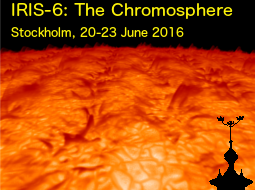Speaker
Hui Tian
(Peking University)
Description
Recent observations by the Interface Region Imaging Spectrograph (IRIS) have revealed
pockets of hot gas (∼8×104 K) resulting from magnetic reconnection in the partially
ionized lower solar atmosphere (IRIS bombs). Using joint observations between IRIS
and the Chinese New Vacuum Solar Telescope, we have identified ten IRIS bombs (IBs).
We find that three are unambiguously and three others are possibly connected to
Ellerman bombs (EBs), which show intense brightening of the extended Hα wings without
leaving obvious signature in the Hα core. These bombs generally reveal the following
distinct properties: (1) The O iv 1401.156 ̊A and 1399.774 ̊A lines are absent or very
weak; (2) The Mn i 2795.640 ̊A line reveals as an absorption feature superimposed on
the greatly enhanced Mg ii k line wing; (3) The Mg ii k and h lines show intense
brightening in the wings and no dramatic enhancement in the cores; (4) Chromospheric
absorption lines such as Ni ii 1393.330 ̊A and 1335.203 ̊A are very strong; (5) The
1700 ̊A images obtained with the Atmospheric Imaging Assembly on board the Solar
Dynamics Observatory reveal intense and compact brightenings. These properties
support the formation of these bombs in the photosphere, demonstrating that EBs can
be heated much more efficiently than what we thought before. We also demonstrate that
the Mg ii k and h lines can be used to investigate EBs similarly to Hα, which opens a
promising new window for EB studies. The rest four IBs obviously have no connection
to EBs and they do not have the properties mentioned above, suggesting a higher
formation layer possibly in the chromosphere. We also find that IBs generally reveal
no obvious coronal signature and that most of them are sitting at the magnetic field
polarity inversion lines.
Primary author
Hui Tian
(Peking University)

